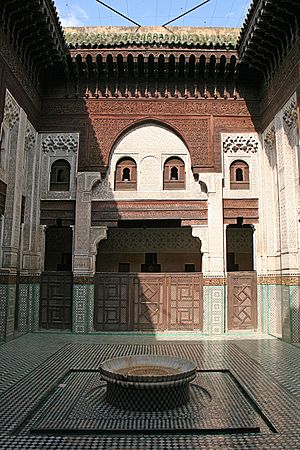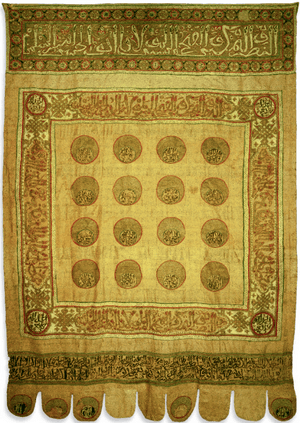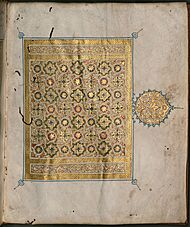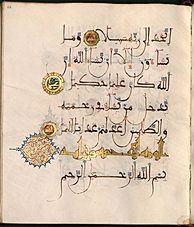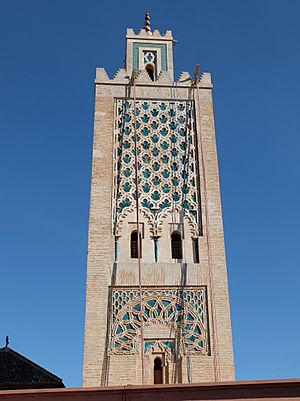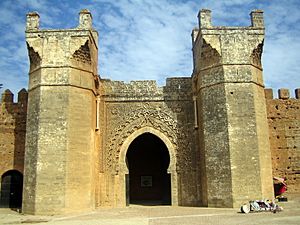Marinid Sultanate facts for kids
Quick facts for kids
Marinid Sultanate
المرينيون al-marīniyyūn (ar)
|
|||||||||
|---|---|---|---|---|---|---|---|---|---|
| 1244–1465 | |||||||||
|
|
|||||||||

The Marinid Sultanate in 1360
|
|||||||||
| Status | Ruling dynasty of Morocco | ||||||||
| Capital | Fes | ||||||||
| Common languages | Arabic, Berber languages | ||||||||
| Religion | Sunni Islam | ||||||||
| Government | Sultanate | ||||||||
| Sultan | |||||||||
|
• 1215–1217
|
Abd al-Haqq I | ||||||||
|
• 1420–1465
|
Abd al-Haqq II | ||||||||
| History | |||||||||
|
• Established
|
1244 | ||||||||
|
• Disestablished
|
1465 | ||||||||
| Currency | Dinar | ||||||||
|
|||||||||
| Banu Abd al-Haqq |
|||
|---|---|---|---|
 |
|||
| Country: | |||
| Parent House: | Banu Marin | ||
| Titles: | Sultan of Morocco | ||
| Founder: | Abd al-Haqq I | ||
| Final Ruler: | Abd al-Haqq II | ||
| Current Head: | none | ||
| Founding Year: | 1215 | ||
| Cadet Branches: | Wattasid dynasty Ouartajin dynasty |
||
|
Part of a series on the
|
|---|
| History of Morocco |
 |
|
|
Classical to Late Antiquity
(8th century BC – 7th century AD) |
|
|
|
|
|
|
Related topics
|
The Marinid Sultanate was a powerful empire ruled by the Berber Marinid dynasty. It existed from the mid-1200s to the mid-1400s. This empire controlled much of what is now Morocco. At different times, it also ruled parts of Algeria, Tunisia, and even southern Spain near Gibraltar. The Marinids were named after the Banu Marin, a Berber tribe.
In 1244, the Marinids took over from the Almohads, who had been ruling Morocco. The Marinid empire was strongest in the mid-1300s. During this time, under sultans like Abu al-Hasan and Abu Inan, they controlled most of the Maghreb (Northwest Africa). They also helped the Emirate of Granada in southern Spain. They even tried to gain control on the European side of the Strait of Gibraltar. However, they lost a big battle called the Battle of Río Salado in 1340. They were finally forced out of Spain in 1344.
From the early 1400s, another related family, the Wattasid dynasty, started to gain power. They acted as powerful advisors (called viziers) or regents for the Marinid sultans. By 1465, the last Marinid sultan, Abd al-Haqq II, was killed during a revolt in Fez. This led to the Wattasids taking full control of Morocco.
Unlike the Almohads, the Marinids made Maliki Sunnism their official religion. They made Fez their capital city. Under Marinid rule, Fez became a very important and prosperous center. The Marinids also built many madrasas (schools) across the country. These schools helped teach Islamic law. Over time, religious leaders called Sufi sheikhs became very influential in the countryside. Families claiming descent from the prophet Muhammad (called sharifian families) also grew in importance. This set the stage for later ruling families like the Saadians and Alaouites.
Contents
History of the Marinids
Where the Marinids Came From
The Marinids were a Berber tribe, even though they sometimes claimed Arab ancestors. They originally lived in the Biskra region of what is now Algeria. Around the mid-1000s, Arab tribes arrived in North Africa. This forced the Marinids to move.
They first traveled between Sijilmasa and Figuig in present-day Morocco. They also reached areas in Algeria. They moved with the seasons, from the Figuig oasis to the Moulouya River. By the early 1200s, they had moved into Morocco in large numbers. The Marinids got their name from their ancestor, Marin ibn Wartajan al-Zenati.
How the Marinids Rose to Power
When the Marinids first arrived in Morocco, they were under the rule of the Almohad dynasty. Their leader, Muhyu, even helped the Almohads win a battle in Spain in 1195. However, he died from his injuries. His son, Abd al-Haqq I, is considered the true founder of the Marinid dynasty.
The Almohads suffered a major defeat against Christian kingdoms in Spain in 1212. This weakened their empire. Starting around 1213, the Marinids began to collect taxes from farmers in northeastern Morocco. This caused tension with the Almohads. Fighting broke out regularly from 1215. In 1217, the Marinids tried to take eastern Morocco but were defeated. Abd al-Haqq was killed.
The Marinids were forced to retreat from cities. Their new leaders, Uthman I and Muhammad I, helped them regroup. They regained control over rural tribes near Taza, Fez, and Ksar el-Kebir. Meanwhile, the Almohads lost their lands in Spain. Other parts of their empire, like Ifriqiya and Tlemcen, also broke away.
In 1244, under the leadership of Abu Yahya, the Marinids began a serious campaign of conquest. Between 1244 and 1248, they captured important cities from the weakened Almohads. These included Taza, Rabat, Salé, Meknes, and Fez. Fez became their capital in 1248. In 1255, they took Sijilmassa.
The Almohad ruler, Sa'id, tried to fight back in 1248. Abu Yahya pretended to surrender and retreated. But Sa'id was ambushed and killed by another group. The Marinids then took over the Almohad army's Christian soldiers. Abu Yahya quickly reoccupied the cities he had taken. His successor, Abu Yusuf Yaqub, captured Marrakesh in 1269. This officially ended Almohad rule.
The Golden Age of the Marinids
After the Nasrids of Granada gave the city of Algeciras to the Marinids, Abu Yusuf went to Spain. He wanted to help the fight against the Christian Kingdom of Castile. The Marinid dynasty then tried to control the important trade routes through the Strait of Gibraltar.
In 1260 and 1267, Christian forces tried to invade Morocco. But both attempts were stopped by the Marinids. From their base in Algeciras, the Marinids took control of several Spanish towns. By 1294, they held Rota, Tarifa, and Gibraltar.
In 1276, the Marinids built a new city in North Africa called Fes Jdid ("New Fez"). This became their main administrative and military center. Fez had been a rich city before, but under the Marinids, it truly became a golden city. It gained its reputation as a major intellectual center during this time. The Marinids built the first madrasas (schools) in the city and the country. Many important buildings in Fez date from the Marinid period.
Sultan Abu Said Uthman II (ruled 1310–1331) started many large building projects. Several madrasas were built, including the famous Al-Attarine Madrasa. These schools helped create a group of educated officials loyal to the government.
The Marinids also had a strong influence on the Emirate of Granada in Spain. They even expanded their army with soldiers from Granada in 1275.
At their peak, under Abu al-Hasan Ali (ruled 1331–1348), the Marinid army was very large and well-trained. It included 40,000 Berber cavalry. Arab nomads and Andalusians also joined. The sultan's personal guards had 7,000 men, including Christians, Kurds, and Black Africans.
Abu al-Hasan tried to unite the entire Maghreb region. In 1337, he conquered the kingdom of Tlemcen. In 1347, he defeated the Hafsid empire in Tunisia. This made him ruler of a huge area, from southern Morocco to Tripoli. However, a year later, Arab tribes revolted in southern Tunisia, and he lost his eastern lands. The Marinids had also suffered a major defeat against a Portuguese-Castilian army in the Battle of Río Salado in 1340. They finally had to leave Spain, only holding Algeciras until 1344.
In 1348, Abu al-Hasan was replaced by his son, Abu Inan Faris. Abu Inan tried to reconquer Algeria and Tunisia. He had some successes, but he was killed by his own official in 1358. After his death, the Marinid dynasty began to weaken.
Decline of the Marinids
After Abu Inan Faris died in 1358, the real power shifted to the viziers (chief ministers). The Marinid sultans became weak and were often replaced quickly. The country became divided and unstable. Different viziers and foreign powers supported different groups.
In 1359, tribes from the High Atlas mountains took over Marrakesh. They ruled it independently until 1526. To the south, Sufi religious leaders claimed their own power. In the 1370s, Azemmour broke away. To the east, the Zianid and Hafsid families regained their independence. In the north, European countries took advantage of the instability by attacking the coast. Wandering Arab tribes also caused more chaos, speeding up the empire's decline.
In the 1400s, the empire faced a financial crisis. The government could no longer pay the religious leaders and noble families who had helped control the tribes. This led to a loss of political support, and the empire broke into smaller parts. In 1399, Tetouan was captured and its people were killed or enslaved. In 1415, the Portuguese captured Ceuta.
After 1420, the Marinid rulers were controlled by the Wattasids. They acted as regents for the young Sultan Abd al-Haqq II. The Wattasids refused to give up power even when Abd al-Haqq grew up.
In 1459, Abd al-Haqq II managed to kill many members of the Wattasid family, breaking their power. However, his rule ended violently. He was murdered during a revolt in 1465. This event marked the end of the Marinid dynasty. A leader of the Sharif families was declared Sultan in Fez. But he was overthrown in 1471 by one of the two Wattasid brothers who survived the 1459 massacre. This Wattasid leader then started the Wattasid dynasty.
Key Events in Marinid History
- 1215: The Marinids begin attacking the Almohads.
- 1217: Abd al-Haqq I dies fighting the Almohads.
- 1244: Muhammad I is killed. Abu Yahya ibn Abd al-Haqq becomes leader.
- 1248: Abu Yahya establishes his capital in Fez.
- 1269: Marinids capture Marrakesh, ending Almohad rule.
- 1276: The Marinids found Fes Jdid ("New Fez").
- 1299: Marinids begin a nine-year siege of Tlemcen.
- 1307: Abu Yaqub Yusuf an-Nasr is killed.
- 1329: Marinids defeat Castilians in Algeciras, Spain.
- 1331: Abu al-Hasan ibn Uthman becomes sultan.
- 1337: Marinids conquer Tlemcen.
- 1340: A combined Portuguese and Castilian army defeats the Marinids at the Battle of Río Salado.
- 1344: Castilians take Algeciras. Marinids leave Spain for good.
- 1347: Abu al-Hasan unites the Maghreb by defeating the Hafsids.
- 1348: Abu al-Hasan dies. His son Abu Inan Faris becomes sultan. The Black Death arrives, and rebellions begin.
- 1358: Abu Inan is killed. A period of weak sultans and powerful viziers begins.
- 1374: The empire splits into two kingdoms: Fez and Marrakesh.
- 1399: King Henry III of Castile captures Tetouan.
- 1415: The Portuguese capture Ceuta. This marks the start of European expansion overseas.
- 1420: Abd al-Haqq II becomes sultan at one year old. The Wattasid family controls the government.
- 1459: Abd al-Haqq II massacres the Wattasid family.
- 1465: Abd al-Haqq II is murdered during a revolt. The Marinid dynasty ends.
- 1472: The Wattasid dynasty begins.
Culture and Achievements
Learning and Education
The Marinids were great supporters of Islamic learning and culture. During their rule, the University of al-Qarawiyyin in Fez became very famous and important. The Marinids also built many madrasas (schools). These schools trained Islamic scholars, especially in Islamic law.
Madrasas were important for the Marinids to strengthen their rule. They helped gain the loyalty of religious leaders in Fez. They also showed the people that the Marinids were protectors of mainstream Sunni Islam. These schools also trained the educated people who worked in the government.
Most madrasas were built in the early 1300s, especially under Sultan Abu al-Hasan. Many were built near large mosques that were already centers of learning. A main purpose of these madrasas was to provide housing for students from other towns. These students were often poor and needed a place to stay while studying.
In Fez, the first madrasa was the Saffarin Madrasa, built in 1271. Other famous ones include the Sahrij Madrasa (1321), the al-Attarine (1323), and the Mesbahiya Madrasa (1346). The last and largest Marinid madrasa in Fez was the Bou Inania Madrasa. It was special because it was also a Friday mosque. Other Marinid madrasas were built in cities like Salé and Meknes. Many more were built across the country but have not survived.
Writers and scholars were very active during the Marinid period. They wrote religious texts, poetry, and scientific works. Histories were also very popular, partly because the Marinid rulers wanted to use them to show their right to rule. The famous historian Ibn Khaldun was a product of this rich intellectual life. Many scholars from this time also spent time in Granada, Spain. The famous traveler Ibn Battuta also visited Morocco in the 1300s and wrote about it.
Art and Craftsmanship
Marinid art continued many styles from earlier dynasties like the Almoravids and Almohads.
Metalwork
Many Marinid religious buildings had large bronze chandeliers, similar to those made by the Almohads. The Marinid chandelier in the Great Mosque of Taza is the largest one remaining in North Africa. It was made in 1294 and is 2.5 meters wide, weighing 3 tons. It could hold 514 oil lamps. It has beautiful floral patterns and Arabic writing.
Other ornate metal chandeliers in the Qarawiyyin Mosque also date from the Marinid era. Some were even made from church bells that Marinid craftsmen used as a base. The largest of these, installed in 1337, was a bell brought from Gibraltar after its recapture in 1333.
Textiles and Banners
Not many Marinid textiles have survived. However, it is believed that luxurious silks were still made. Three impressive banners captured from Sultan Abu al-Hasan's army in 1340 are now in the Toledo Cathedral in Spain. These banners show how important they were. Ibn Khaldun wrote that Sultan Abu al-Hasan had hundreds of silk and gold banners.
The oldest banner is from 1312. It was made in Fez for Sultan Abu Sa'id Uthman. It is mostly green silk with blue, white, red, and gold patterns. It has religious phrases and large Arabic writing.
The second banner was made for Abu al-Hasan in 1339 or 1340. It is mostly yellow with blue, red, and gold details. It has prayers for the sultan's victory.
A third banner, less preserved, is also from Abu al-Hasan's time. Its inscriptions are painted, not woven. Some scholars think it might have been a cheaper version for soldiers or a template for weavers.
Manuscripts
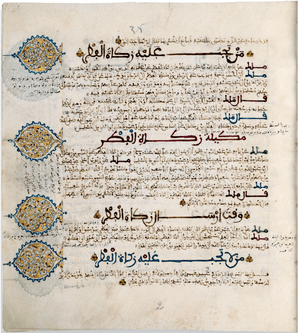
Many Marinid manuscripts have been preserved. One great example is a Qur'an commissioned by Sultan Abu Yaqub Yusuf in 1306. It has beautiful illuminated pages and is written in a clear Arabic script.
Many sultans were skilled calligraphers themselves. Sultan Abu al-Hasan was especially known for copying Qur'ans. He copied four Qur'ans, sending them to important mosques in Chellah, Medina, Mecca, and Jerusalem. His son, Abu Inan, also copied religious texts.
Besides Qur'ans, many other religious and legal texts were copied. These include works from the Maliki school of Islamic law. These manuscripts show that important writing workshops existed in Fez, Salé, and Marrakesh.
Minbars (Pulpits)
The minbars (pulpits) from the Marinid era followed the style of earlier Almoravid and Almohad minbars. The minbar in the Great Mosque of Taza dates from the 1290s. It is a mobile staircase with an archway and a canopy. Its sides are covered with detailed geometric decoration. These patterns are made with marquetry (inlaid pieces of wood) and ivory.
The original minbar of the Bou Inania Madrasa is now in the Dar Batha museum. It was made between 1350 and 1355. It is one of the best Marinid examples. It is made of expensive woods like ebony and decorated with marquetry and carved patterns.
Architecture and Buildings
The Marinid dynasty greatly improved the artistic styles from earlier Almoravid and Almohad times. In Fez, their capital, they built monuments with very detailed decorations. These were often made of wood and stucco. They were also the first to widely use zellij (colorful mosaic tiles with complex geometric patterns). This style became very common in Moroccan architecture.
Their architectural style was very similar to that of the Nasrid dynasty in Granada, Spain. The famous Alhambra palace in Spain looks a lot like buildings in Fez from the same time. When Granada was conquered by Christian Spain in 1492, many Spanish Muslims and Jews moved to Morocco. This further increased the Spanish cultural influence in the region.
The Marinids were the first to build madrasas (schools) in the region. The madrasas in Fez, like the Bou Inania, al-Attarine, and Sahrij madrasas, are considered some of the best architectural works of this period. The Marinid madrasas in Salé and Meknes are also very important.
Mosque architecture generally followed the Almohad style. However, the Marinids started making the sahn (courtyard) larger. In later periods, the courtyard became as big as or even bigger than the main prayer hall. Important Marinid mosques include the Grand Mosque of Fes el-Jdid (1276), the expanded Great Mosque of Taza (1294), and the Mosque of al-Mansourah near Tlemcen (1303). The Ben Salah Mosque in Marrakesh also dates from this time.
Little remains of the Marinid royal palaces in Fes el-Jdid. The current Royal Palace of Fez is mostly from a later dynasty. The former Marinid Royal Gardens have also disappeared. The Marinid Tombs on the hills overlooking Fes el-Bali are mostly in ruins.
However, some Marinid monumental gates still stand today. These include the gate of the Chellah necropolis near Rabat and the Bab el-Mrissa in Salé. They show similarities to earlier Almohad designs.
List of Marinid Rulers
Here is a list of the Marinid rulers from the start of their dynasty to its end:
1215–1269: Leaders of the Marinids, fighting against the Almohads, based in Taza from 1216 to 1244
- Abd al-Haqq I (1215–1217)
- Abu Sa'id Uthman I (1217–1240)
- Abu Ma'ruf Muhammad I (1240–1244)
After 1244: Marinid Emirs based in Fez
- Abu Yahya ibn Abd al-Haqq (1244–1258)
- Abu Yusuf Yaqub (1258–1269)
1269–1465: Marinid Sultans of Fez and Morocco
- Abu Yusuf Yaqub (1269–1286)
- Abu Yaqub Yusuf al-Nasir (1286–1307)
- Abu Thabit 'Amir (1307–1308)
- Abu al-Rabi Sulayman (1308–1310)
- Abu Sa'id Uthman II (1310–1331)
- Abu al-Hasan 'Ali (1331–1351)
- Abu Inan Faris al-Mutawakkil (1348–1358)
- Abu Zayyan Muhammad II (1358; first reign)
- Abu Yahya Abu Bakr ibn Faris (1358–1359)
- Abu Salim Ibrahim ibn 'Ali (1359–1361)
- Abu 'Amr Tashfin ibn 'Ali (1361)
- Abu Zayyan Muhammad II (1361–1365; second reign)
- Abu Faris Abd al-Aziz I al-Mustansir (1365–1372)
- Abu Zayyan Muhammad III (1372–1374)
- Abu 'l-Abbas Ahmad I al-Mustansir (1373–1384, 1387–1393)
- Abu Faris Musa ibn Faris (1384–1386)
- Abu Zayyan Muhammad IV ibn Ahmad I (1386)
- Abu Zayyan Muhammad V ibn Ali (1386–1387)
- Abu 'l-Abbas Ahmad II ibn Ahmad I (1387–1393)
- Abu Faris Abd al-Aziz II ibn Ahmad II (1393–1396)
- Abu 'Amir Abdallah ibn Ahmad II (1396–1397)
- Abu Sa'id Uthman III (1398–1420)
- Abu Muhammad Abd al-Haqq II (1420–1465)
Images for kids
-
Sculpted decoration, including muqarnas, around the courtyard of the Bou Inania Madrasa in Fes
See also
 In Spanish: Sultanato benimerín para niños
In Spanish: Sultanato benimerín para niños




